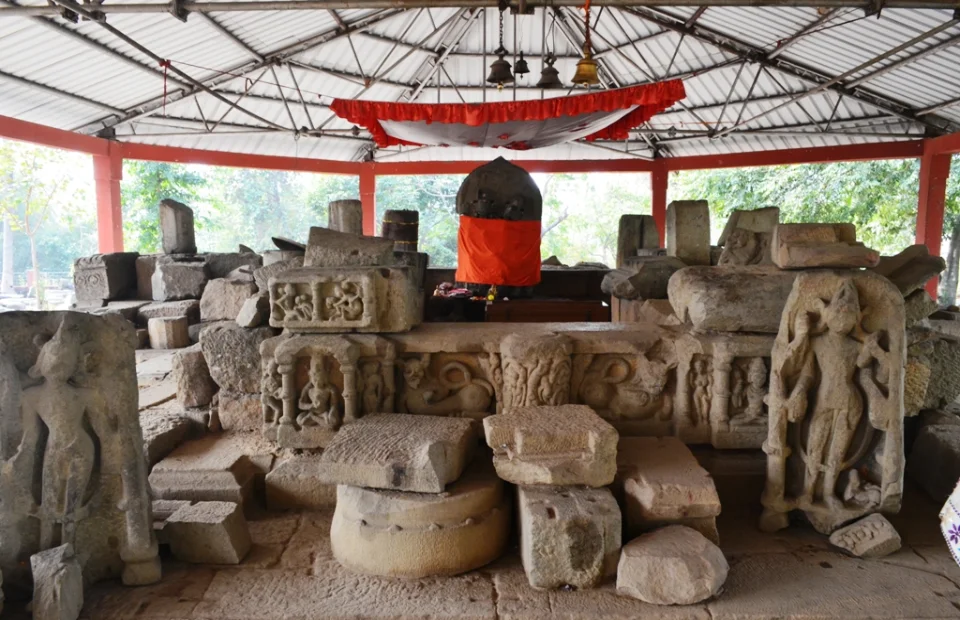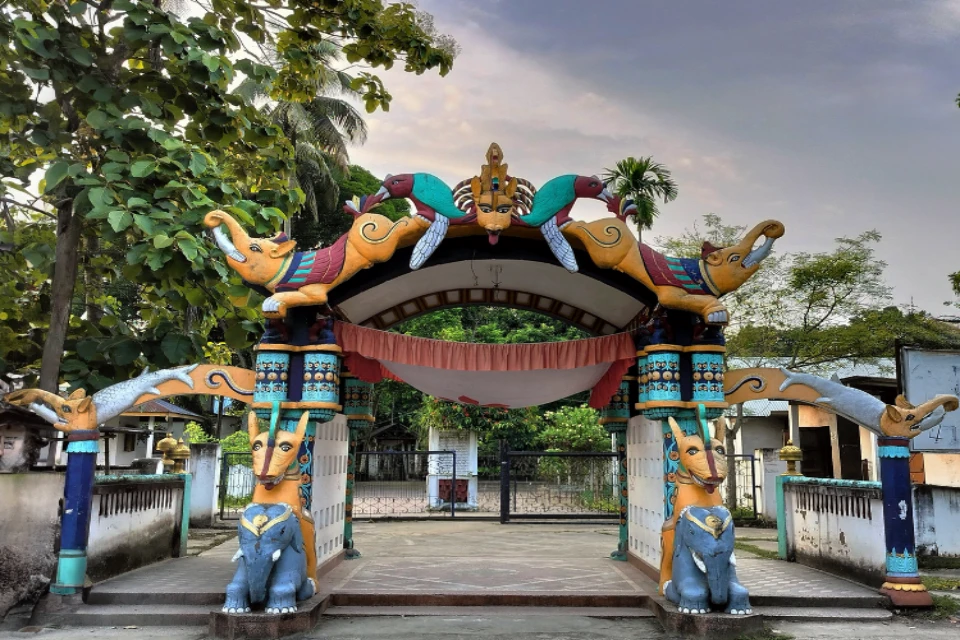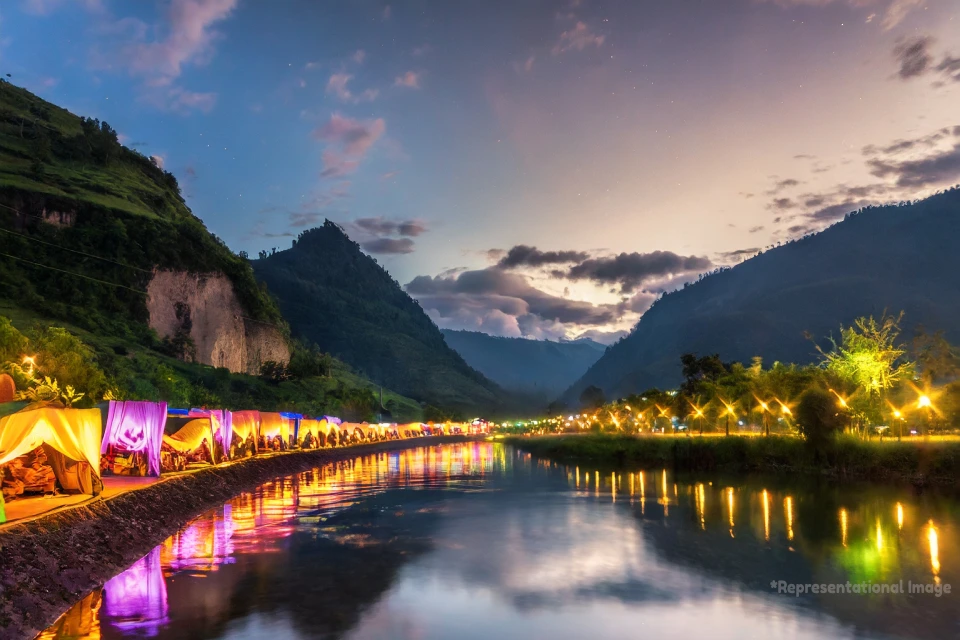Discover the ancient charm of Madan Kamdev Temple, often called Assam’s Khajuraho. Explore its mystical ruins, intricate carvings, and serene surroundings.
Rituparna Borgohain
Updated on :
Share this post
Assam’s rich heritage hides a glorious chapter of history spanning hundreds of years. It holds a vast treasure of exquisite artistry. Just as Assam is blessed with lush biodiversity, it is equally enriched in religion, art, and culture. Every corner of Assam echoes with vibrant tales of history.

Image: The ancient stones and sculptures of Madan Kamdev Temple
The ancient Kamarupa kingdom was known for its culture, sculptures, and Tantra practices. Its hidden remnants are now a valuable part of our history. One of the finest examples of this rich heritage is the Madan Kamdev Temple. Known as the “Khajuraho of Assam,” this Hindu temple showcases the grandeur of the Pala dynasty in Assam. The carvings depict the legendary tales of Kamdev, the Hindu god of love. Dedicated to Lord Shiva, this temple remains an important place of worship where devotees offer prayers and seek blessings. Today, it stands as one of Assam’s most significant archaeological sites.
The Madan Kamdev Temple, influenced by the Nagara style of medieval temples, is located in Baihata Chariali, near Kathipara in North Guwahati, Kamrup district of Assam. It is situated atop the Dewangiri Hill.
Discover more on Madan Kamdev Temple
Reasons to Visit Madan Kamdev Temple
If questions arise like, “Why visit this temple? What is specific about it? Then let’s explore what makes this temple so captivating that it always draws visitors towards it. From its mysterious ruins to its incredible natural beauty, you will be mesmerized.
Educational Tour
Madan Kamdev temple is unique from the rest of the temples in Assam. This temple is mentioned in ‘Kalika Purana ’ and ‘Yogini Tantra.’ The temple also comes up in Rajnikant Bordoloi’s ‘Donduadruh’. The temple was ruined. It is unknown how this temple was destroyed. From the ruined sculptures, some say it seems an earthquake destroyed them. The destroyed parts of the temple are preserved in a nearby museum. To study our history more, it is crucial to visit and research this temple as it is compared to the Khajuraho temples. It is also significant for an archaeological survey.
Visit for Fulfillment
Perched atop Dewangiri Hill, the Madan Kamdev Temple is surrounded by incredible natural beauty. From here, one can admire the remarkable scene of the Brahmaputra Valley stretching into the horizon. The lush greenery, the fresh air gently brushing against your skin, and the melodious chirping of birds create an enchanting atmosphere. As you stand amidst the ancient ruins, a sense of peace and mysticism envelops you, making this place a perfect retreat from the chaos of daily life.
Spiritual Visit
The Madan Kamdev Temple has a sculpture of a ruined sculpture of God Maheshwar and Goddess Uma. This half-destroyed idol of Maheswar and Uma is worshipped by people as ‘Madan- Kamdev.’ This site is significant for the devotees to seek blessings and explore the temple’s divine aura.
Various festivals are celebrated at this temple throughout the year. Three main festivals observed here are Madan Trayodashi Tithi, Maha Shivratri, and Ganesh Chaturdashi. Among them, Madan Trayodashi Tithi is celebrated with great happiness on the Shukla Trayodashi Tithi of the Assamese Chaitra month (March-April).
During Madan Trayodashi, a specific bamboo puja is performed, where two bamboo poles are worshipped. The significance of this festival lies in the legend that when Kamadeva was reduced to ashes by Lord Shiva’s fiery wrath, his wife, Rati Devi, prayed to Lord Shiva. Moved by her devotion, Shiva restored Kamadeva to life on this very day. Hence, the festival of Madan Trayodashi Tithi is celebrated in remembrance of this event.
Also Read: 9 Famous Temples in Guwahati to Visit in 2025
Activities to do
Puja/Aarti: You can visit this temple for worship and prayers at any time of the week. Devotees come here to offer puja and seek blessings in a peaceful spiritual atmosphere. The temple remains open for visitors from 9 AM to 5 PM.
Relaxation: The temple area is a few kilometers away from Guwahati. Therefore, the atmosphere of the area is very calm and peaceful. People may find both relaxation and knowledge from this site.
Photography: The Madan Kamdev Temple area is splendid for photography. Since this is a ruined temple, the different types of sensational sculptures, inscriptions, etc., give the perfect vibe for an archeological photoshoot. In addition, the greenery and flowing river from the nearby create a magnificent view for the photographers.
How to Get There
Madan Kamdev Temple is well-connected by road, and you can easily find buses, taxis, and private cabs to reach the site. After reaching the base, you need to climb a flight of stairs to reach the temple on the hill.
By Road: The temple is about 34 km from Guwahati via NH 27, passing through the Saraighat Bridge. You can take a bus or taxi to Baihata Chariali and hire a local vehicle to the temple base.
By Train: The nearest railway station is Kamakhya Junction, about 30 km away, while Guwahati Railway Station is approximately 37 km away via NH 27. You can take a bus or taxi to Baihata Chariali from those stations.
By Air: Lokpriya Gopinath Bordoloi International Airport is the closest airport, located around 40 km away via NH 17 and NH 27. Taxis and cabs are available from the airport to the Madan Kamdev Temple base.
The History of Madan Kamdev Temple
The Prevailing Story Regarding the Origin
Located a short distance from Guwahati, the Madan Kamdev Temple silently reveals a living chapter of Assam’s mythological history. The ruins scattered around the site seem to conceal many mysteries.
According to popular legends, Kamdev is the Hindu god of love. Ancient tales mention that when Kamdev disrupted Lord Shiva’s meditation, an enraged Shiva burned him to ashes. However, Kamdev’s wife, Rati Devi, worshipped Lord Shiva and pleaded for her husband’s revival. Pleased with her devotion, Shiva restored Kamdev’s form. It is believed that the place where Kamdev regained his form was named Kamrup. The temple site is said to be where Kamdev reunited with his wife, Rati Devi, and together, they built several temples dedicated to Lord Shiva.
Another reference from the Kalika Purana identifies this location as the Matsya Dhwaj Mountain. The south-flowing Saswati River also traverses the site. In his travelogue, “Kamarupar Teertha Bhraman,” Chandrakumar Agarwala referred to this river as the Mora Nodi or Dead Stream, also known as “Madanakur.”
There is a belief regarding the use of bricks in this temple that some parts were constructed during the Ahom era. However, based on the style of the Madan Kamdeva idol, historians speculate that it was built during the reign of the Pala dynasty. The Assam Archaeology Department suggests that the temple was constructed around the 11th–12th century.
However, a closer examination of the sculptural features reveals that some of the idols date back to the 9th century CE. Several renowned Pala rulers, such as Brahmapala and Ratnapala, ruled over Kamarupa (ancient Assam) in that period. This leads historians to assume that the temple was built during the reign of the Pala dynasty in Assam.
More details about the Pala rule in Assam can be found in K.L. Barua’s Early History of Kamarupa and S.L. Baruah’s A Comprehensive History of Assam. The Palas of Kamarupa were followers of Tantric practices, and it is believed that they constructed several Tantric temples across Assam.
The Prevalent Story About the Destruction of the Temple
There are various legends regarding the destruction of the Madan Kamadeva Temple. According to the locals, the temple was destroyed by Kalapahar. However, there is no concrete evidence to support this claim.
On the other hand, the Archaeological Survey suggests that the temple was ruined due to an earthquake. This conclusion is drawn from the alignment of the ruins, which appear to have collapsed uniformly, indicating that an earthquake was the likely cause of its destruction.
Architecture & Sculptural Significance
There is no definitive information about who built the Madan Kamdev Temple or when it was constructed. This historically rich site was thoroughly examined only in 1970. Excavations in the temple area uncovered the ruins of 24 small and large temples, which had been buried under dense forests and vegetation for centuries. The discovered architectural and sculptural remnants reflect Assam’s rich artistic heritage.
Spread over a small area, the site contains numerous ruins, including intricately carved statues of gods, goddesses, humans, animals, flowers, and leaves. Some of these remnants depict erotic sculptures, similar to those found in Khajuraho. Because of this, the Madan Kamdev Temple is often referred to as the “Khajuraho of Assam.”
The temple features a Garbhagriha (sanctum sanctorum), influenced by the Nagara style of medieval temple architecture. On three sides of the sanctum, there are idols of three goddesses. On the left side of the main sanctum is a goddess identified in the Kalika Purana as Tritiya Tripura Devi. Inside the sanctum, an idol is currently covered with red cloth. This sculpture is a real-life Uma-Maheshwara, depicting the embrace of Lord Shiva and Goddess Parvati.
Among the ruins of Madan Kamdev Temple, large pillars can be seen, intricately carved with floral and other natural motifs. A beautifully designed door jamb was also discovered in the temple area throughout excavations. This door jamb features a portrait of an elephant being attacked by two human figures, each holding a trident.
Additionally, symbols of the Kalpavriksha (the wish-fulfilling tree) are observed on these door jambs with large and artistically carved leaves. In the central part of the door jambs, an idol of Lord Ganesha is also visible.
The site features a Vaikuntha Vishnu sculpture, regarded as one of the most significant in all of India. Additionally, a temple in the Ratha style was discovered here, which is unique in Assam, as no other temple in the region follows this architectural style. Its plinth remains in excellent condition, while the Mandapa and Garbhagriha are still beautifully connected.
Among the various sculptures discovered here, some depict dancing figures. Several Surya (Sun God) idols are also found in this temple, showing a clear influence of South Indian Surya sculptures. When compared to South Indian temple sculptures, it is observed that South Indian Surya idols usually have bare feet and hold two partially bloomed lotuses in their hands. The Surya sculptures at Madan Kamdev Temple exhibit the same characteristics.
Endnotes
Madan Kamdev Temple is more than just a historical site; it’s a doorway to Assam’s glorious past, wrapped in myth and artistry. Whether you’re an explorer, a history lover, or someone seeking peace in nature’s lap, this hidden gem has something for you. Lose yourself in the mesmerizing ruins, let the whispers of time enchant you, and take home a piece of Assam’s untold story.
Which dynasty did order the construction of Madan Kamdev Temple?
The Madan Kamdev Temple is believed to have been built during the rule of the Pala dynasty in Assam, between the 9th to 12th centuries. The Palas were known for their patronage of art, architecture, and Tantra practices, which is reflected in the intricate carvings and sculptures found at the temple site.
What kind of sculpture can be found in Madan Kamdev Temple?
The Madan Kamdev Temple features exquisite sculptures of Hindu deities, dancing apsaras, mythological figures, and erotic carvings, similar to Khajuraho. The temple walls and pillars showcase Lord Shiva, Goddess Parvati, floral motifs, and animal figures. These intricate carvings reflect the artistic brilliance of the Pala dynasty.
What is Madan Kamdev famous for?
Madan Kamdev is famous for its ancient temple ruins, intricate stone carvings, and mythological significance. Known as the “Khajuraho of Assam,” it showcases sculptures of Hindu deities, celestial nymphs, and erotic figures. The site is also linked to the legend of Kamdev and Rati, making it a place of historical, religious, and artistic importance.
Which is known as the Khajuraho of Assam?
Madan Kamdev Temple is known as the “Khajuraho of Assam” due to its intricate stone carvings, which resemble the sculptures found in Khajuraho temples in Madhya Pradesh. The temple features exquisite depictions of Hindu deities, celestial nymphs, and romantic sculptures, making it one of Assam’s most significant archaeological sites.

Rituparna Borgohain is a passionate explorer and writer. She is a history graduate from Sibsagar College with a keen interest in uncovering the social and cultural history of Assam. She loves exploring places and expressing the stories through her writing. Reach her at rituparna@diversityassam.com.


